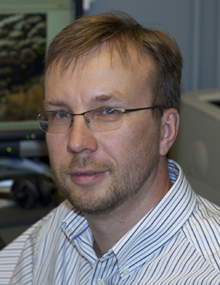
Igor Grigoriev, Ph.D
Fungal Genomics Program Lead, DOE Joint Genome Institute
Following postdoctoral training and several years of work in the pharmaceutical industry, Dr. Grigoriev joined the DOE Joint Genome Institute in 2003 to participate in human genome annotation and lead annotation of over 100 diverse eukaryotic genomes from protists to plants. In 2009, he started the Fungal Genomics program to scale up sequencing and analysis of diverse fungi for related to DOE science and applications. Dr. Grigoriev organized over 30 genomics workshops and engaged over 2000 researchers around the world in genome projects, which resulted in over 50 high-profile publications. In the same vein, he and his team are working to organize research labs around large-scale, most-needed genomics projects to develop genetic blueprints for diverse algae to enable comparative and functional algal genomics.
Education
- BA/MS in Biophysics, Moscow Engineering Physics Institute, Moscow, Russia
- PhD in Molecular Biology, Research Institute for Genetics and Selection of Industrial Organisms, Moscow, Russia
- Postdoctoral training in computational structural genomics, University of California, Berkeley, CA
Selected Publications
- Riley et al (2016) Comparative genomics of biotechnologically important yeasts. Proc Natl Acad Sci U S A. 113(35):9882-7.
- Corrochano et al (2016) Expansion of signal transduction pathways in fungi by extensive genome duplication. Curr Biol. 26(12):1577-1584.
- Dhillon et al (2015) Horizontal gene transfer and gene dosage drives adaptation to wood colonization in a tree pathogen. Proc Natl Acad Sci U S A. 112(11):3451-3456.
- Kohler et al (2015) Convergent losses of decay mechanisms and rapid turnover of symbiosis genes in mycorrhizal mutualists. Nature Genet. 47(4):410-415.
- Grigoriev et al (2014) MycoCosm portal: gearing up for 1000 fungal genomes. Nucleic Acids Res.42(1):D699-704.
- Riley R et al. Extensive sampling of basidiomycete genomes demonstrates inadequacy of the white-rot/brown-rot paradigm for wood decay fungi. Proc Natl Acad Sci U S A. 2014; 111: 9923-9928.
- Tisserant E et al. Genome of an arbuscular mycorrhizal fungus provides insight into the oldest plant symbiosis. Proc Natl Acad Sci U S A. 2013; 110: 20117-20122.
- Read B et al. Pan genome of the phytoplankton Emiliania underpins its global distribution. Nature. 2013; 499: 209-213.
- Curtis BA Algal genomes reveal evolutionary mosaicism and the fate of nucleomorphs. Nature. 2012; 492: 59-65.
- Ohm RA et al. Diverse lifestyles and strategies of plant pathogenesis encoded in the genomes of eighteen dothideomycetes fungi. PLoS Pathog. 2012; 8(12):e1003037.
- Floudas D et al. The Paleozoic origin of enzymatic lignin decomposition reconstructed from 31 fungal genomes. Science. 2012;336: 1715-1719.
- Berka RM et al. Comparative genomic analysis of the thermophilic biomass-degrading fungi Myceliophthora thermophila and Thielavia terrestris. Nat Biotechnol. 2011; 29: 922-927.
- Eastwood DC et al. The plant cell wall-decomposing machinery underlies the functional diversity of forest fungi. Science. 2011; 333: 762-765.
- Gobler CJ et al. Niche of harmful alga Aureococcus anophagefferens revealed through ecogenomics. Proc Natl Acad Sci U S A. 2011; 108: 4352-4357.
- Banks JA et al. The Selaginella Genome Identifies Genetic Changes Associated with the Evolution of Vascular Plants. Science, 2011; 332: 960-963.
- Colbourne JK et al. The ecoresponsive genome of Daphnia pulex. Science. 2011; 331: 555-561.
- Ohm RA et al. Formation of mushrooms and lignocellulose degradation encoded in the genome sequence of Schizophyllum commune. Nat Biotech. 2010; 28: 957-963.
- Worden AZ et al. Green evolution and dynamic adaptations revealed by genomes of the marine picoeukaryotes Micromonas. Science. 2009; 324: 268-272.
- Bowler C et al. The Phaeodactylum genome reveals the dynamic nature and multi-lineage evolutionary history of diatom genomes. Nature. 2008; 456: 239-244.
- Martin F et al. The genome of Laccaria bicolor provides insights into mycorrhizal symbiosis. Nature. 2008; 452: 88-92.